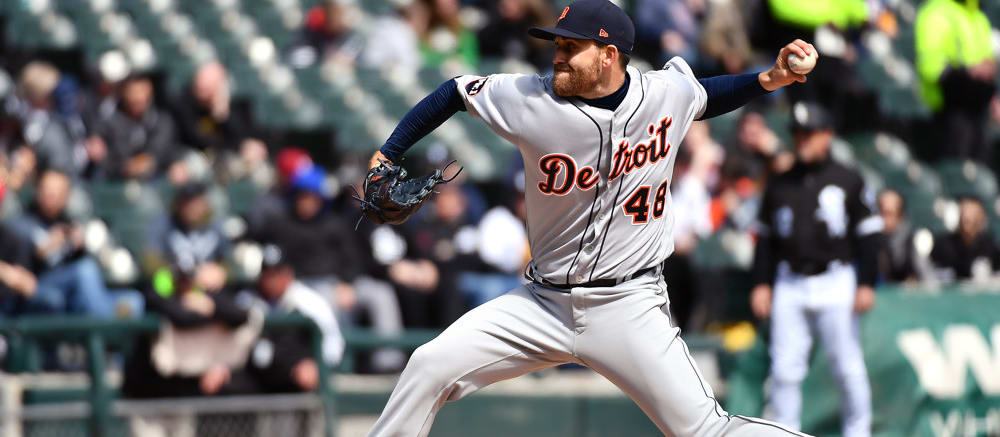This article is part of our Collette Calls series.
Recall the premise of this annual series of bold predictions stated in the first installment:
It's time, once again, to put myself out there and make 60 predictions for the new season. The premise for this annual article series remains the same: the prediction has to be somewhat grounded in reality but at the same time viewed as unlikely when you first read it. So, you will not find me predicting Ryan Yarbrough to win the Cy Young, but you may see me making calls predicting a breakout for Corbin Burnes as I did in this series just last year. Conversely, you will find some big misses such as me laying out the case why Shane Bieber would not finish the season as a top-20 starting pitcher.
When you play in the margins with predictions, you are going to lose more than you will win. The last three seasons, I've hit on 21 to 24 of the 60 predictions I've made with some rather big hits (Renato Nunez, Blake Snell, Lance Lynn, Jose Abreu) and many more misses. Just last year, this series helped identify the upside of taking a chance on A.J. Pollock, Andrew McCutchen, Asdrubal Cabrera, Ian Happ, Marcell Ozuna, Trent Grisham, Chris Bassitt, the aforementioned Burnes, Tony Gonsolin, and Justus Sheffield.
While I strive for higher rates of accuracy, you will not see me lower the credentials for predictions to increase the
Recall the premise of this annual series of bold predictions stated in the first installment:
It's time, once again, to put myself out there and make 60 predictions for the new season. The premise for this annual article series remains the same: the prediction has to be somewhat grounded in reality but at the same time viewed as unlikely when you first read it. So, you will not find me predicting Ryan Yarbrough to win the Cy Young, but you may see me making calls predicting a breakout for Corbin Burnes as I did in this series just last year. Conversely, you will find some big misses such as me laying out the case why Shane Bieber would not finish the season as a top-20 starting pitcher.
When you play in the margins with predictions, you are going to lose more than you will win. The last three seasons, I've hit on 21 to 24 of the 60 predictions I've made with some rather big hits (Renato Nunez, Blake Snell, Lance Lynn, Jose Abreu) and many more misses. Just last year, this series helped identify the upside of taking a chance on A.J. Pollock, Andrew McCutchen, Asdrubal Cabrera, Ian Happ, Marcell Ozuna, Trent Grisham, Chris Bassitt, the aforementioned Burnes, Tony Gonsolin, and Justus Sheffield.
While I strive for higher rates of accuracy, you will not see me lower the credentials for predictions to increase the chances of the prediction coming true. My goal is not to go 60 for 60 on these; it is to get you thinking differently about each one of these players. Statistical predictions in player capsules or writeups are, at best, within the range of accuracy 70 percent of the time. My purpose is to get you thinking about what could potentially happen in the other 30 percent of the pie.
The small sample of 2020 compounded with all of the related factors in prepping for and playing through a season during a pandemic loom large in the statistics, which is why you'll see a focus on timelines rather than solely focusing on the previous season.
All ADP is from the last 60 days from 108 NFBC drafts
Chicago
Adam Eaton (ADP 359; high 224, low 483) is a top-60 outfielder. Eaton is currently the 90th outfielder off the board, and I firmly believe that presents a value for early drafters in 2021. There are two primary drivers to his market price: recency bias and health history. Eaton had a terrible 2020 by any measure, capped off by breaking his finger during a bunt (NEVER BUNT!) in September, which shut down his season. It was the third time in four seasons Eaton failed to play injury-free, as he has had one season in that span in which he played as many as 70 percent of the games. The temptation is what Eaton pulled off in 2019 when he was a productive fantasy player hitting atop a talented Washington lineup. Fast forward to 2021 and Eaton once again finds himself hitting high in a talented lineup in Chicago.
Last season, Chicago utilized five players in the second spot of the lineup, led by Yoan Moncada, who filled the spot 40 times. He earned the right to hit high in the lineup with his strong 2019 performance, but Moncada's 2020 numbers fell back to his 2018 levels, and a .320 OBP from the second spot of the lineup does not cut it. His switch-hitting abilities helped offset the right-heavy setup of the lineup, but his OBP against righties was lower than his overall OBP last year at .308. Compare Moncada and Eaton's OBP in recent seasons to see who is the better fit high in the lineup:
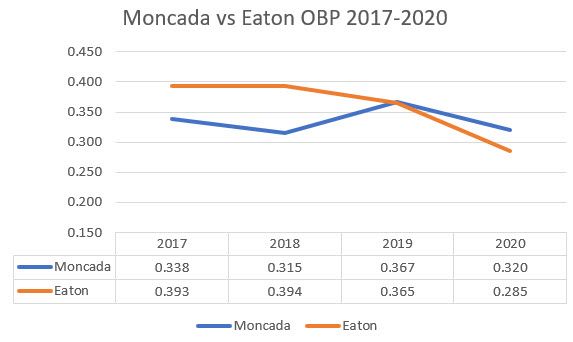
Both players accept walks, but Eaton strikes out with a much lower frequency, permitting him more opportunities to reach base, and still has the speed to leg out infield hits. Eaton is the perfect fit between Tim Anderson and the big boppers in the heart of the Chicago lineup. Eaton would be a push to hit double-digit homers even in a full season, but 100-plus runs and double-digit steals along with a resurgent batting average are absolutely on the table for a guy on a one-year contract motivated to get another multi-year deal in 2022. The risk is always the injury bug staying with Eaton like a Remora fish on a shark.
Michael Kopech (ADP 288; high 197, low 401) is a top-75 pitcher. Kopech is currently the 106th pitcher off the board, which is understandable given we have not seen him throw a pitch in a major league game since Sept. 5, 2018. He left that game injured and had Tommy John surgery two weeks later. He rehabbed all 2019 and looked good in Arizona in February and March before things were shut down, and he opted out of the 2020 season. He hit 100 mph in an outing last spring, but velocity makes it back before command with TJ rehabs. Had Kopech pitched in 2020, we likely would have seen the same type of command issues that have befallen other pitchers in their first season back from the surgery.
I likely sound like a broken record at this point, but I let other fantasy owners roster these rehabbing pitches in months 12-23 post-surgery as the risks simply outweigh the rewards. Once the pitcher gets to the 24th month, I'm looking to acquire that pitcher as things tend to get better for the pitcher from then on. Kopech is now 28 months removed from his surgery, albeit without an actual season of pitching in games involved. He opted out of last season even though he was not in a high-risk profile nor was he injured. Former pitching coach Don Cooper mentioned in an interview he hoped Kopech was OK, bringing up the pitcher's well-documented history with anxiety and depression. I found it rather appalling the coach would even talk like that in an interview with a reporter, and maybe that is why Cooper is now the former pitching coach. Cooper had been the pitching coach in Chicago for 18 years, but the club brought in Ethan Katz this winter. Katz, not Cooper, was the guy responsible for rebuilding Lucas Giolito into the pitcher we see today.
Katz is already working with the pitchers remotely, including Kopech via bullpen video workouts in Texas. Katz has prioritized working with Kopech to get him to trust his secondary pitches so that he is not so predictable with his fastball in hitter counts. Kopech has both a plus slider and curve with a lagging changeup, but a good curve can be an effective substitute for a changeup with the proper shape. When Kopech pitched in my backyard in Charlotte in 2018, he was on his way to making this happen.
This prediction is built of the combination of a new approach, a fully recovered arm and the soft skills of a new voice in his ear helping him achieve his full potential in a way that best works for him.
Cleveland
Nolan Jones (ADP 587; high 434, low 690) is a top-450 player. Jones is currently the 50th third baseman off the board and has no plate appearances above Double-A, yet I believe there is fantasy upside to him this year. Evan White was in a similar status last season, but White had more pressure on him with the long-term deal signed before his first major league plate appearances and the pressures of playing first base while making the Opening Day roster. Jones does not have the contract, and is unlikely to make the opening day roster, but the path ahead is rather easy to navigate.
Jones played shortstop in high school and has played third base as a professional, but spent the fall instructional league playing both first base and outfield. The projected Opening Day first baseman is Jake Bauers — who could not get off the alternative site roster in 2020 — while the corner outfield shows Josh Naylor and Daniel Johnson. None of those players should lock down a job and Jones has the arm to play both corner outfield positions. Jones owns a .283/.409/.448 batting line in four minor league seasons and was performing at a high level in Double-A at age 21.
Jones has plenty of power and more should come as he completes his physical maturity. With great power comes great contact issues, as he has struck out below the league average at nearly every stop in the minors, so the power projection does not come without its batting average risk. At the end of the day, the power is what will get him to the big leagues, and only Franmil Reyes and Jose Ramirez has more of it on the club. Cleveland is in a youth movement and needs to see what else it has to fill the gaps around its two notable hitters. Cleveland's outfield offensive production has been a big question for a couple seasons now, and Jones has the potential to fix it as soon as this season.
Triston McKenzie (ADP 187; high 133, low 286) is not a top-100 pitcher. McKenzie is currently the 67th pitcher off the board, but I am not tempted to take him anywhere close to that myself. McKenzie is so slight he could possibly be confused as a local high school kid serving as the bat boy, as the 160 pounds that clings to his 6-foot-5 frame struggles to fill out the uniform. Once he unleashes a pitch, any doubts are eliminated. The kid can pitch. Scouts grade his entire repertoire and his command as slightly above average or better. The problem with him has been durability with back, lat and pectoral strains in 2018 and 2019 as well as issues holding his velocity deeper into outings.
The high-water mark for McKenzie's workload is 143 innings, which he did back in 2017 while starting 25 games. 2018 was a 90-inning affair, and he missed 2019 due to the lat and pec strains. He worked 33 innings last season for Cleveland, and now is being projected for the rotation. I would be stunned if he threw more than 100 innings this season because asking a pitcher to go from 0-33-133 IP over a two-year stretch before age 24 is asking a lot, especially from one with a questionable durability track record and a slight frame.
I believe McKenzie has a bright future, but the projections appear to be setting lofty expectations from a body that has not held up to the developmental workloads of pitching the last few years, let alone pitching through a major league season.
Detroit
Robbie Grossman (ADP 412; high 218, low 550) is a top-350 player. Grossman is currently the 101st outfielder off the board, going just after teammate JaCoby Jones and just before Hunter Renfroe. Jones and Grossman are projected to be starting outfielders, while Renfroe is not guaranteed a full-time position. Grossman has value because he could end up hitting leadoff, or at worst, second in the lineup. Given his splits are not as extreme as others, Grossman is likely to remain in those lineup spots. He has a career 13 percent walk rate and a .350 on-base percentage and should be ideal for the top of the lineup. While he is up there, he can leverage his stolen-base acumen, given he is 17 for his last 21 in steals the last two seasons for an Oakland club that typically does not like to run.
Grossman has never hit more than 11 homers, scored more than 62 runs or stolen more than nine bases in a single season, yet each of those totals should be attainable with a guaranteed full-time job nor a logical righty bat to take away playing time in a platoon situation. Grossman has a limit to his ceiling in that he has shown particular troubles against breaking balls the last two seasons, hitting .152 and .179 against those pitches over a 633-pitch sample size but has done well with fastball and offspeed pitches. On a better team, this would be a big reach, but Grossman's new contract means he is a starter for this club and barring injury, he is going to have a career year compiling stats for an also-ran club.
Matthew Boyd (ADP 321; high 215, low 408) is a top-60 pitcher. Boyd is currently the 123rd pitcher off the board, going just behind fellow 2020 gas cans Mitch Keller and Caleb Smith and just in front of Noah Syndergaard and Yusei Kikuchi. Yes, Boyd was my bold prediction last year — he was going to be a top-40 starting pitcher and it blew up on me like most of his outings last season blew up on our respective fantasy rosters. That said, I'm back in for 2021, but not with the same level of excitement.
Something clearly was not right with Boyd last year, and it first appears in his numbers:
Pitch Type | 2019 Avg Velo | 2020 Avg Velo | 2019 Avg Spin | 2020 Avg Spin |
|---|---|---|---|---|
Four-seam | 92.1 | 91.7 | 2383 | 2305 |
Slider | 79.6 | 79.3 | 2377 | 2323 |
Changeup | 79.1 | 79.1 | 1956 | 1900 |
Curveball | 72.2 | 74.1 | 2247 | 2528 |
Sinker | 90.2 | 90.5 | 2353 | 2255 |
The four-seamer lost a little velo and some spin with it, the league hit .322 and slugged .643 off the lesser fastball compared to .269 and .535 from the previous season. The slider was essentially the same pitch, and it was really his best pitch both seasons albeit a little worse in 2020. The changeup was essentially the same pitch and performed nearly on par with its 2019 numbers. The sinker lost quite a bit of spin and got trashed worse than his four seamer (.364 avg) compared to the .290 from 2019.
Then there is his vertical release point, or the height by which he released his pitches. After consecutive seasons of lowering his arm slot and getting more movement on his pitches, something changed and he threw his pitches from a higher release point than he used in 2019, especially so with the curveball.
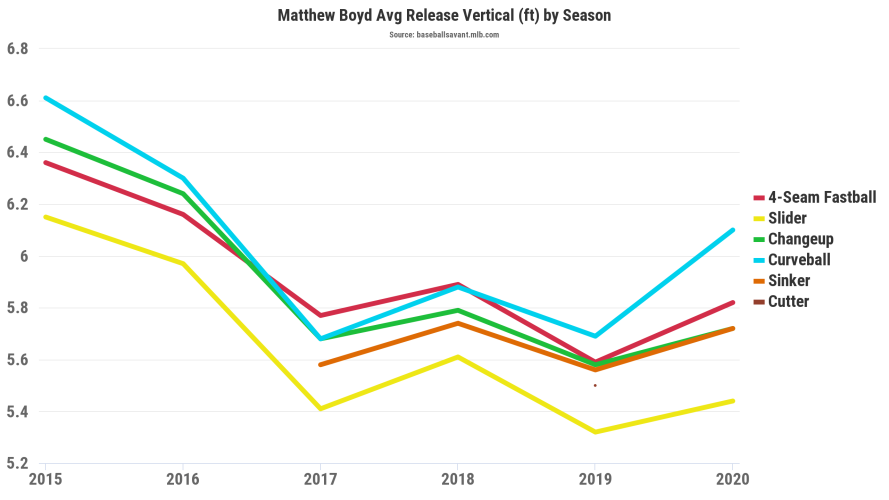
Sure enough, Boyd stated in a recent interview he suffered a hamstring injury in summer camp and had to adjust his mechanics on the fly and then doubled down on the physical matters with plantar fasciitis toward the end of the season:
"Physically, it affected me in terms of being able to repeat my delivery," Boyd said Monday. "There was no pain for the majority of the year, but my mechanics moved and adapted to where I wasn't able to do the same things on the mound that I used to."
The home runs may always be an issue given Boyd's flyball tendencies, but these injury tidbits help us to better understand why he took such a step backward in 2020 after his positive showing in 2019. This admission to injury is going push him up the charts in some leagues, but others will struggle to set aside their recency bias to try again with Boyd. Those of us who do, especially as long as he stays outside the top-100 pitcher board, will be rewarded.
Kansas City
Edward Olivares (ADP 489; high 326, low 590) is a top-75 outfielder. Olivares is currently the 111th outfielder off the board, going just behind Stephen Piscotty and Marwin Gonzalez and just in front of Tyler O'Neill and Kevin Kiermaier. This prediction obviously needs him to win an outfield job out of camp, which is possible given Oliveras can man all three outfield positions while Michael Taylor profiles more as a reserve/platoon with Franchy Cordero than he does an everyday outfielder. Not to mention, the club could always move Whit Merrifield back to second base and put Nicky Lopez into a reserve infield role.
Olivares was one of two (Cordero the other) outfielders Kansas City acquired from San Diego during the 2020 season. So much has been made of everything San Diego has given up to acquire talent this offseason that we almost forget they gave up Cordero, Oliveras and Franmil Reyes in recent trades and all are likely going to be near-everyday players in their roles. Oliveras had a productive minor-league career offensively with a rather impatient approach at the plate, but his work in Double-A in 2019 allowed him to reach back at a .349 clip and steal 35 bases around 18 homers, 85 runs and 77 RBIs. He struggled against big-league pitching as a rookie last season after leaping over the dormant Triple-A option, but showed flashes of his ability.
Oliveras has the tools to win a job out of camp and stay in the lineup, albeit toward the bottom of the lineup barring injury or an explosion of skills. The 1-5 in Kansas City seems set in stone, but Oliveras could hit as high as sixth in the lineup on normal days. This is the kind of player the club should want in the lineup everyday as he has upside whereas someone like Taylor has known limitations that would be exploited in an everyday role. Olivares is being drafted mostly with the disappointing and downtrodden outfielders from 2020, but his upside is as high as any outfielder currently outside the top 100.
Scott Barlow (ADP 546; high 304, low 738) is a top-150 pitcher. Barlow is currently the 212th pitcher off the board behind the likes of Justin Dunn and Kyle Gibson and just in front of Edward Cabrera and Vince Velasquez. We can safely assume the closer role will be filled by Greg Holland to begin the season, and he certainly earned it the way he pitched for the club last season after his acquisition. That said, Ian Kennedy earned the right for the role the way he pitched in 2019 and look what happened to him. Holland has also previously pitched his way out of the closer role due to serious walk issues in 2018 and 2019. The Royals have a low investment in Holland, so they hope they can get good production from him and flip him before the deadline to a contender.
Should Holland falter or be moved Barlow and Josh Staumont are next in line. Staumont (ADP 448; high 281, low 533) is clearly the market favorite to be the next man up because he has the fastball that touches 102 mph while Barlow does his best work with his non-fastballs. Yet, a side-by-side comparison of career outcomes to date is where things get interesting:
Pitcher | TBF | HR/9 | GB% | K% | K-BB% | AVG | WHIP | OPS vs RH | OPS vs LH | 2020 Whiff% |
|---|---|---|---|---|---|---|---|---|---|---|
Staumont | 200 | 1.2 | 31% | 26% | 13% | .241 | 1.49 | .710 | .781 | 37% |
Barlow | 500 | 0.9 | 42% | 29% | 19% | .240 | 1.35 | .666 | .787 | 38% |
Why exactly are these two pitchers nearly 100 spots apart on ADP when the guy lower on the ADP charts? Barlow has more egregious splits as his approach is incredibly tough on righties, but both he and Staumont have their issues against lefties. In fact, it's a systemic issue in the organization when you look at Brad Keller and Jakob Junis as well as it is clear the club decides early whether a pitcher can throw a changeup or just decides to tell the pitcher to shelve it and try the curveball as the offspeed pitch.
Either way, Barlow is going to pitch in high-leverage situations and has taken his strikeouts to a new level once he dialed back on his fastball and started spinning more sliders and curves. As long as the market is going to value these two similar pitchers this far apart, Barlow presents an excellent buying opportunity with significant upside should Holland have another bout of control troubles.
Minnesota
Trevor Larnach (ADP 689; high 449, low 742) is a top-100 outfielder. Larnach is the 148th outfielder off the board the last two months as he will be in the minors to start the season. Alex Kirilloff is the top outfield prospect in the organization, and if Minnesota does not bring back Nelson Cruz, could make the team as the DH. I challenge that at some point early in the season, Larnach could also come up and I ask the Twins ...

Larnach hit .311/.428/.517 in three seasons at Oregon State and has hit .307/.385/.468 in two minor-league seasons, making it as high as Double-A in 2019 for just more than 180 plate appearances. The time in Double-A was the first time he showed issues with contact, but has been an OBP machine anywhere he has played and scouts love the power potential in his swing. He turns 24 this offseason, so there is no reason to slow play this prospect outside of the suspect defense. Perhaps it is he and not Kiriloff who should serve as the DH if the Twins decide to get younger on offense and reallocate money that would have gone to Cruz to other spots on the lineup. The upside with this kid is enticing while the fragility of Byron Buxton or the true talent level of Jake Cave — currently projected as the starters in center and left — scream opportunity for Larnach in 2021.
Hansel Robles (ADP 712; high 413, low 746) is a top-400 overall player. He is the 306th pitcher off the board after a disastrous 2020 season in which he created a new definition for horrendous reliever. I can't believe he is sucking me back in here again, but this is what I said about Robles last year when I predicted a breakout for him:
He has added two miles an hour to his fastball over the past two seasons, taking his average four-seam velocity from 95.2 to 97.4. That increase has helped take his swinging-strike rate on the pitch from 8.8% up to 11.2 percent and the pitch value score went from 4.1 in 2017 to 8.9 last year. Robles ramped up his changeup usage last year and nearly quadrupled his swinging-strike rate on the pitch from 5.6 percent in 2018 to 19.5 percent last season. The pitch had nearly disappeared from his repertoire while in New York, but the usage and the performance of the pitch jumped up to a new level last year on the west coast.
Robles was one of many pitchers who did not handle the layoff between spring and summer camp very well as he lost two mph off his fastball:
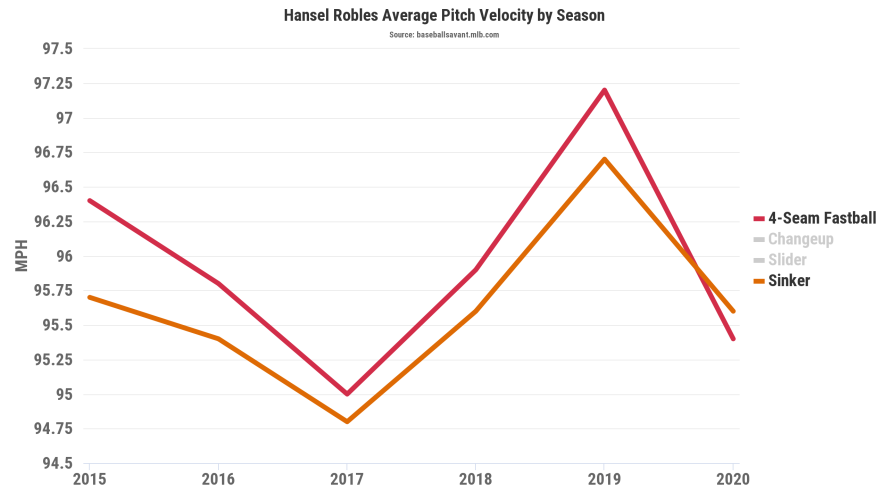
The league hit .209 with a .211 xBA off his 97mph heater in 2019, but teed off to a .355 (.330 xBA) off the 95 mph heater last season as not only was the pitch slower, it lacked the spin and life it had in 2019 as he took his step forward in the Angels bullpen:
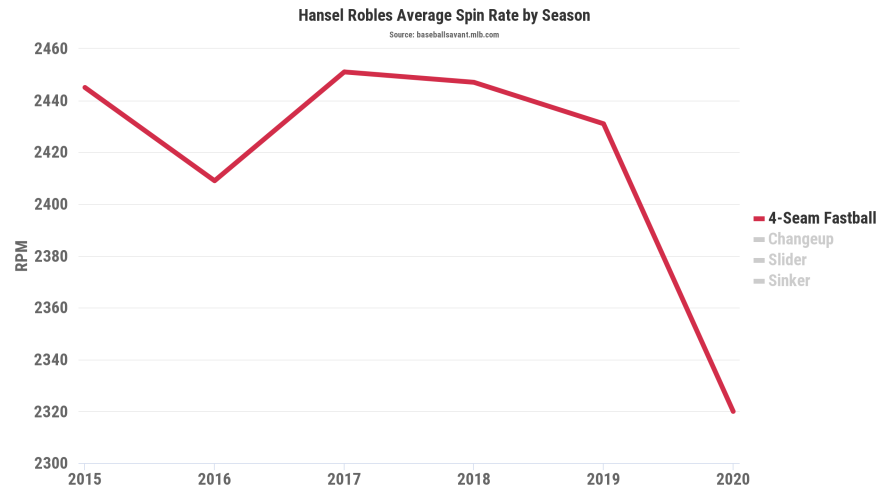
Ironically, despite the issues, Robles generated more swings-and-misses than any other season. He is but a season removed from this kind of profile, and if his velocity shows up again in the spring, he could take a big leap forward and earn his way back into late-leverage situations for Minnesota piling up strikeouts and being in situations to earn late wins as the staff lacks the pitchers that will work deep into games. He is a reserve round or draft and hold dart throw that could turn a nice profit should he rediscover what made him good in 2019.

